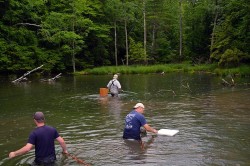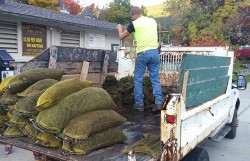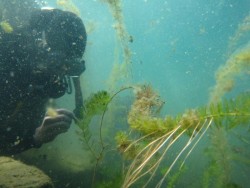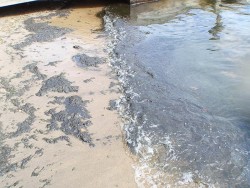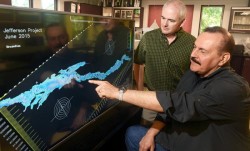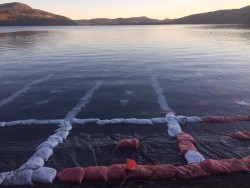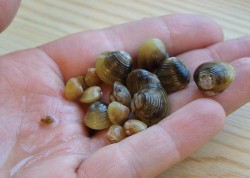
Technology tracks the toll road salt, phosphorus, and invasive species are taking on Lake George
Ancient legends say that when a mermaid dies, her soul rises from the depths to become foam, or spindrift. On a chilly late October afternoon, I stood among the souls of the watery departed along Sawmill Bay on New York’s Lake George, known across the country as the Queen of American Lakes. The spindrift created a foamy bracelet around the bay, and each wave whispered gently as it arrived, perhaps bringing a message of distress to those who would listen.
I grew up on Lake George, and my family and countless other residents and visitors have long drawn water to drink directly from the lake, classified as “AA-Special” by the state of New York for the quality of its water.
Now, however, the future of the 32-mile-long lake, a gift from the glaciers 10,000 years ago, is in question. Scientists refer to Lake George as an oligotrophic lake. Such lakes have low amounts of phosphorus, clear waters, and little to no algae growth; eutrophic lakes contain high amounts of phosphorus, with ever-increasing populations of algae. Studies show that Lake George is slowly changing, and becoming more eutrophic. Since the 1970s, Lake George’s famed water clarity has declined by about six percent.
From winter road salt that washes into the Queen’s waters, to pollutants like phosphorus, to the invasive species that have taken up residence on her shores, the monarch is ailing. Many lakes across the Adirondacks and New England face similar threats.
Road Salt: The Acid Rain of Our Time
To learn more about efforts to help Lake George, I ventured to Sawmill Bay on the lake’s western shore to visit the Rensselaer Polytechnic Institute’s (RPI) Darrin Fresh Water Institute (DFWI). The DFWI property is a patchwork quilt of old and new.
Buildings dating to the early 1900s, including a main lodge that looks more like an Adirondack Great Camp than a laboratory, are interspersed with brand new labs such as the Jefferson Project’s Data Visualization Lab, with its high-definition display that lights up an entire wall and brings data from the project to life in near-real time.
There I met Rick Relyea, an aquatic ecologist and director of the project, a high-tech collaboration among DFWI, computer giant IBM, and the Fund for Lake George, an organization dedicated to protecting the lake. “The idea is to use monitoring, experimentation, modeling, and forecasting to inform decision-makers in ways that lead to lasting protection of the lake’s water quality,” said Relyea.
Beneath the surface, the Queen’s status may be slipping from good to fair. Efforts like the Jefferson Project, which began in 2013, are underway to help reverse this trend. Lake George is being monitored by sensors – some floating, some submerged – that track vital signs such as water temperature and dissolved oxygen and send the measurements back to shore. “The gauges also keep tabs on salt content – among the most serious threats to the lake,” said Relyea.
Scientist Jeff Short, a consultant to the Fund for Lake George, added that “salt is the acid rain of our time.”
The Lake George region usually receives more than 70 inches of snow each winter. During those months, some 9,000 tons of road salt, or sodium chloride – an estimated 13 tons per lane mile – are applied to snow- and ice-covered streets and highways in the Lake George watershed. Where is all that salt going? “Much of it drains into the lake,” said Short.
Salt levels in Lake George have tripled since 1980, scientists revealed in the 2014 report The State of the Lake: Thirty Years of Water Quality Monitoring on Lake George, New York, 1980–2009. Short is a co- author of the report, jointly released by the DFWI and the Fund for Lake George. “Allowing salt to continue rising,” he stated, “risks irreversible changes in the lake’s ecosystem.”
Added Relyea, “Finding out how extensive the effects may be requires doing the research to learn how the lake works and how humans are affecting it. Through the Jefferson Project, we have an opportunity to understand Lake George with a level of detail that was previously unimaginable.”
For example, “circulation models are showing us how road salt is transported and how it moves through the lake,” said Harry Kolar, an engineer at IBM and the company’s lead researcher on the project.
Road salt that runs off roads drains into streams that feed Lake George, causing these tributary waters to become more dense, the scientists have found. That has the potential to alter patterns of water circulation.
Jefferson Project researchers plan to dot Lake George with 41 sensor-carrying platforms, said Kolar. As of January 2016, they had deployed 20. Vertical profilers monitor water temperature, chlorophyll, and dissolved organic matter. Weather stations track humidity, barometric pressure, and wind velocity. Tributary stations record information from water entering the lake via streams. And acoustic Doppler current profilers, or ADCPs, measure lake currents.
Scientists around the globe have their eyes on the Jefferson Project, hoping its results may be applicable to lakes in other states and countries.
One of the project’s most recent platforms is a Lake George tour boat, the steam-propelled paddlewheeler Minne-Ha-Ha, which now carries an extra passenger: an ADCP mounted on the ship’s hull. “The mobile ADCP measures currents at different locations and different times of day as the Minne makes its circuit,” said Mike Kelly, an engineer at IBM who’s taking part in the research. “The information we obtain will be fed into water circulation and other models, helping us understand things like how long road salt stays in the lake.”
Phosphorus: Too Much of a Good Thing
Salt isn’t the only thing that’s polluting Lake George. Excess phosphorus leaking from rusting septic systems, aging sewage-treatment plants, lawn fertilizer, and household detergent, said Short, are fueling growth of the lake’s phytoplankton. The microscopic algae – which clump together to form green or brown slicks when they reach very high numbers – have increased in the lake by as much as 33 percent over the past four decades.
Rainbow smelt, introduced into the lake in the early twentieth century, are complicating the picture. The fish feast on microscopic floating animals called zooplankton. If zooplankton are removed from the water, phytoplankton reproduce very quickly, often resulting in large, visible “blooms.” When these plant plankton ultimately die, they sink to the lake’s depths, where they create oxygen-deprived dead zones.
Jefferson Project researchers are tracking how phosphorus makes its way into the lake from tributary streams and brooks. While the scientists seek answers, the Fund for Lake George, the Lake George Association (LGA), and other organizations are educating lakeshore landowners about the importance of keeping septic systems in good working order, and not using phosphorus-containing fertilizer and detergent. “One pound of phosphorus can produce up to 500 pounds of wet algae,” said Walt Lender, executive director of the LGA.
Invaders on the Shore
Eurasian watermilfoil. The name strikes fear into the hearts of boaters, marina owners, swimmers, and fishers around the lake for its ability to crowd out native plants, foul boat propellers, and smother swimming areas. It was discovered in Lake George in 1985, and spread quickly.
Last year, divers working for the Lake George Park Commission (LGPC), which has teamed with the LGA and the Fund for Lake George to fight invasive species in the lake, hand-harvested some 111,000 pounds of Eurasian watermilfoil. That’s more than the weight of three full-sized school buses. As a result, the number of lake sites needing attention is down from about 225 to 150, said Dave Wick, executive director of the LGPC.
But there are other invasives to worry about. On a warm late August afternoon, Wick zoomed in on an LGPC boat to pick me up at a dock near Lake George Village, and we headed for Boon Bay on the lake’s west side. There, we lowered the boat’s ladder and jumped into the water with sieves to sift sand for Asian clams. The clams, first found in the lake five years ago, thrive in shallow waters with sandy bottoms. Most of Lake George is too deep for the clams, which are limited to the lake’s edge.
Wick brought up a sieve filled with the invasive clams. The LGPC and other organizations have tried to eradicate Asian clams by covering them with plastic mats weighed down with sandbags and rebar. “That’s worked, but only so well,” said Wick.
The hope is that a native aquatic worm with a taste for Asian clams will offer new answers. Researchers at the DFWI are studying the worm, known as Chaetogaster. It works its way into the mantle cavity of an adult clam, said Sandra Nierzwicki-Bauer, director of the DFWI. “These worms have been found in Asian clams in some places in the lake, but not in others,” said Nierzwicki-Bauer. She’s now comparing clams with and without worms to determine whether Chaetogaster could be used as a biological control.
The LGPC, with the help of the LGA and the Fund for Lake George, is spearheading a mandatory Lake George invasive species boat-inspection program. Boat owners trailering their vessels to the lake must stop at one of several inspection points for clearance. The boats are carefully checked from stem to stern for evidence of invaders. The program has become a model for others around the country.
At Boon Bay, we climbed back into the LGPC boat and were soon on our way south toward Lake George Village. As we arrived, the first signs of sunset appeared. A mile offshore, a floating Jefferson Project platform, its solar panels giving the appearance of all-seeing eyes, kept watch over a darkening bay. A high-tech guard on duty to protect the Queen.


